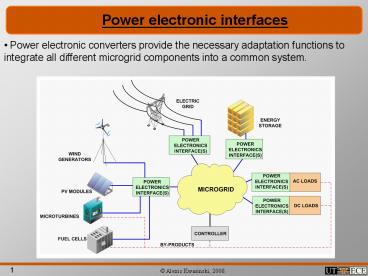Power electronic interfaces - PowerPoint PPT Presentation
1 / 12
Title:
Power electronic interfaces
Description:
Power electronic interfaces. Power electronic converters provide the necessary ... ac-dc: rectifier. dc-ac: inverter. ac-ac: cycloconverter (used less often) ... – PowerPoint PPT presentation
Number of Views:554
Avg rating:3.0/5.0
Title: Power electronic interfaces
1
Power electronic interfaces
- Power electronic converters provide the
necessary adaptation functions to integrate all
different microgrid components into a common
system.
2
Power electronic interfaces
- Integration needs
- Component with different characteristics
- dc or ac architecture.
- Sources, loads, and energy storage devices
output. - Control issues
- Stabilization
- Operational issues
- Optimization based on some goal
- Efficiency (e.g. MPPT)
- Flexibility
- Reliability
- Safety
- Other issues
- Interaction with other systems (e.g. the main
grid)
3
Power electronics basics
- Types of interfaces
- dc-dc dc-dc converter
- ac-dc rectifier
- dc-ac inverter
- ac-ac cycloconverter (used less often)
- Power electronic converters components
- Semiconductor switches
- Diodes
- MOSFETs
- IGBTs
- SCRs
- Energy storage elements
- Inductors
- Capacitors
- Other components
- Transformer
- Control circuit
4
Power electronics basics
- Types of interfaces
- dc-dc dc-dc converter
- ac-dc rectifier
- dc-ac inverter
- ac-ac cycloconverter (used less often)
- Power electronic converters components
- Semiconductor switches
- Diodes
- MOSFETs
- IGBTs
- SCRs
- Energy storage elements
- Inductors
- Capacitors
- Other components
- Transformer
- Control circuit
Diode
MOSFET
SCR
IGBT
5
Power electronics basics
- dc-dc converters
- Buck converter
- Boost converter
- Buck-boost converter
6
Power electronics basics
- Rectifiers
v
v
v
t
t
t
Rectifier
Filter
7
Power electronics basics
- Inverters
- dc to ac conversion
- Several control techniques. The simplest
technique is square wave modulation (seen below). - The most widespread control technique is
Pulse-Width-Modulation (PWM).
8
Power electronics basic concepts
- Energy storage
- When analyzing the circuit, the state of each
energy storage element contributes to the overall
systems state. Hence, there is one state
variable associated to each energy storage
element. - In an electric circuit, energy is stored in two
fields - Electric fields (created by charges or variable
magnetic fields and related with a voltage
difference between two points in the space) - Magnetic fields (created by magnetic dipoles or
electric currents) - Energy storage elements
- Capacitors Inductors
L
C
9
Power electronics basic concepts
- Capacitors
- state variable voltage
- Fundamental circuit equation
- The capacitance gives an indication of electric
inertia. Compare the above equation with Newtons
- Capacitors will tend to hold its voltage fixed.
- For a finite current with an infinite
capacitance, the voltage must be constant. Hence,
capacitors tend to behave like voltage sources
(the larger the capacitance, the closer they
resemble a voltage source) - A capacitors energy is
10
Power electronics basic concepts
- Inductors
- state variable current
- Fundamental circuit equation
- The inductance gives an indication of electric
inertia. Inductors will tend to hold its current
fixed. - Any attempt to change the current in an inductor
will be answered with an opposing voltage by the
inductor. If the current tends to drop, the
voltage generated will tend to act as an
electromotive force. If the current tends to
increase, the voltage across the inductor will
drop, like a resistance. - For a finite voltage with an infinite
inductance, the current must be constant. Hence,
inductors tend to behave like current sources
(the larger the inductance, the closer they
resemble a current source) - An inductors energy is
11
Power electronics basics
- Harmonics
- Concept periodic functions can be represented
by combining sinusoidal functions - Underlying assumption the system is linear
(superposition principle is valid.) - e.g. square-wave generation.
12
Power electronics basics
- Additional definitions related with Fourier
analysis































